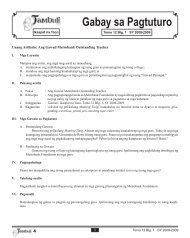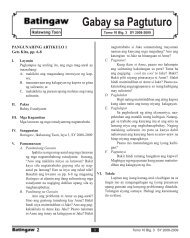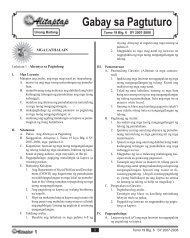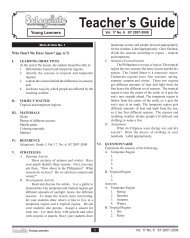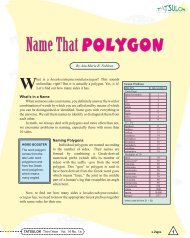Teacher's Guide - Diwa Learning Systems
Teacher's Guide - Diwa Learning Systems
Teacher's Guide - Diwa Learning Systems
Create successful ePaper yourself
Turn your PDF publications into a flip-book with our unique Google optimized e-Paper software.
6<br />
Grade 6<br />
HEALTH: Breathe in, Breathe out<br />
I. <strong>Learning</strong> Objectives<br />
At the end of the lesson, the pupils are expected to be<br />
able to:<br />
a. discover the proper way of breathing;<br />
b. give importance to the lungs; and<br />
c. do the abdominal breathing exercises correctly.<br />
II. Subject Matter<br />
Breathing<br />
III. Materials<br />
Pictures of living or non-living things that give off air<br />
such as electric fan, trees, people, animals, airconditioner,<br />
etc.<br />
IV. References<br />
Hagibis Grade 6, Vol. 13, No. 3, SY 2008-2009<br />
Breath. www.energybalancing.com/health/breath.html<br />
Breathing. www.perf2ndwind.org/html/breathing.html<br />
Health Hint: Breathing exercises. www.amsa.org/healingthehealer/breathing.cfm<br />
V. Strategies<br />
A. Motivation<br />
1. Show the things that give off air.<br />
2. Ask the pupils what common characteristic do<br />
the pictures have. Encourage the pupils to share<br />
their answers.<br />
B. Developmental Activities:<br />
1. Show the pictures to the class again. While<br />
showing the pictures, tell the class the importance<br />
of air on earth.<br />
2. Ask the children how people take in air into the<br />
body and how they expel air out of the body.<br />
Tell them that the air we breath contains oxygen<br />
that our body needs.<br />
3. Ask the pupils what would happen if the hold<br />
their breathe. Allow several pupils to share their<br />
answers.<br />
4. Ask a follow up question: Is there a proper way<br />
to breath? Again, allow the children to share<br />
their answers.<br />
Teacher’s <strong>Guide</strong><br />
Vol. 13 No. 3 SY 2008-2009<br />
5. Explain to the pupils that breathing is important<br />
because it is through breathing where we draw<br />
oxygen that our bodies need. Tell them that<br />
while our body can get oxygen through any<br />
kind of breathing, proper breathing maximizes<br />
the available oxygen in the air.<br />
6. Have a discussion about the proper way of<br />
breathing.<br />
7. After the discussion, lead the class in performing<br />
abdominal breathing exercises.<br />
C. Generalization<br />
Breathing is very important. You should know<br />
the proper way of breathing and it is best to practice<br />
the proper way of breathing to have a healthier<br />
life.<br />
D. Assignment<br />
Assign the pupils to research on the different<br />
exercises that can help develop healthy lungs.<br />
VI. Evaluation<br />
Evaluate the pupils by giving them an essay-type quiz.<br />
VII. Questionnaire<br />
Direction: Explain briefly the following questions.<br />
1. Why do people need to breathe properly?<br />
2. Name some abdominal breathing techniques/exercises.<br />
VIII. Other Teaching Ideas<br />
Start the class with a light physical activity. Bring<br />
the class to the gym or playground. Have them jog a few<br />
laps around the gym or field. Tell them to jog at a relaxed<br />
pace. After a few laps, bring them back to the classroom.<br />
Allow them to rest for a minute or two before starting the<br />
lesson. Let them share how they felt after running. After<br />
they shared their answers, start discussing the importance<br />
of air and breathing. Explain to them the importance of<br />
proper breathing and some abdominal exercises to be<br />
practiced often.<br />
1 Vol. 13 No. 3 SY 2008-2009
MUSIC: Andante and Allegro Sing-Along<br />
I. <strong>Learning</strong> Objectives<br />
At the end of the lesson, the pupils are expected to be<br />
able to:<br />
a. differentiate andante and allegro;<br />
b. name the different techniques in singing allegro<br />
songs; and<br />
c. appreciate music.<br />
II. Subject Matter<br />
Andante and allegro<br />
III. Materials<br />
None required.<br />
Optional: lyrics and minus one recordings of andante and<br />
allegro songs, CD or cassette tape player<br />
IV. References<br />
Hagibis Grade 6, Vol. 13, No. 3, SY 2008-2009<br />
Singing tips. www.dogandponysound.com/sing_tip7.<br />
htm<br />
Which is easier to sing, a slow song or a fast song?<br />
http://answers.yahoo.com/question/index?qid=200<br />
71207193737AA5Iiif<br />
V. Strategies<br />
A. Motivation<br />
1. Sing a few stanzas of different andante and allegro<br />
songs.<br />
2. Ask the class if they noticed any difference in<br />
the songs.<br />
B. Developmental Activities:<br />
1. Lead the class is singing a few andante and allegro<br />
songs. If you want, you can play a minus<br />
one recording as an accompaniment.<br />
2. After the singing session, ask the pupils how<br />
they felt while singing the songs. Ask if the<br />
encountered some difficulties in singing some<br />
of the songs.<br />
3. Ask those who answered yes what difficulty<br />
they encountered while singing the songs.<br />
4. Have a discussion about andante and allegro.<br />
Challenge the pupils to categorize the songs<br />
they sang into andante and allegro.<br />
5. Discuss the tips on singing andante and allegro<br />
songs.<br />
C. Generalization<br />
Andante and allegro are musical terms that can<br />
be used to describe tempo. They are Italian words.<br />
D. Assignment<br />
Divide the class into groups. Tell the class that<br />
they are to come up with a group project. Assign them<br />
6<br />
to make a compilation of andante and allegro songs.<br />
They are to submit the compilation on a CD.<br />
VI. Evaluation<br />
Evaluate the pupils by giving them an essay-type quiz.<br />
VII. Questionnaire<br />
Answer the following questions.<br />
1. Name three tips in singing allegro songs. Explain<br />
how each tip cam help briefly.<br />
2. Name three tips in singing slow songs or ballads.<br />
Explain how each tip cam help briefly.<br />
VIII. Other Teaching Ideas<br />
Invite volunteers to sing fast and slow songs. Ask<br />
them if they had difficulties in singing the songs. Tell<br />
them to give tips on how to sing fast and slow songs.<br />
Write the tips on the board. Add tips that were not mentioned<br />
in the article.<br />
ART: T’boli’s Pretty Jewels<br />
I. <strong>Learning</strong> Objectives<br />
At the end of the lesson, the pupils are expected to:<br />
a. discover the culture of T’boli people;<br />
b. be able to name and describe some of T’boli jewelry;<br />
c. be able to recognize T’boli jewelry as a form of art;<br />
and<br />
c. be able to appreciate T’boli jewelry.<br />
II. Subject Matter<br />
T’boli jewelry<br />
III. Materials<br />
Samples of T’boli jewelry (If samples are not available,<br />
you can use pictures. Just make sure that the pictures are<br />
colored and as detailed as possible.)<br />
IV. References<br />
Hagibis Grade 6, Vol. 13, No. 3, SY 2008-2009<br />
Beaded dresses and ornaments of T’boli women of<br />
Mindanao, the Philippines. www.thebeadsite.com/<br />
SEAC2-03.html<br />
Tboli. http://litera1no4.tripod.com/tboli_frame.html<br />
Preserving culture: T’boli of Mindanao. www.devcomm.<br />
com/tboli_culture.htm<br />
V. Strategies<br />
A. Motivation<br />
1. Show the class some samples of T’boli jewelry.<br />
If samples are not available, show the pupils<br />
2 Vol. 13 No. 3 SY 2008-2009
detailed pictures of T’boli jewelry. You can<br />
pass the samples or pictures around to allow<br />
the pupils to take a better look at them.<br />
2. Ask them what they think about the jewelry.<br />
3. Tell them that what you showed are just samples<br />
of jewelry of a group of indigenous people<br />
called T’boli.<br />
B. Developmental Activities<br />
1. Begin the lesson by sharing some facts about<br />
the T’boli people. Tell them where they can be<br />
found, and it is not unusual to see them dressed<br />
on as if there was a special occasion even though<br />
it is an ordinary day.<br />
2. Tell the class that T’boli people like wearing<br />
jewelry that they make by hand.<br />
3. Let the pupils realize how artistic T’boli people<br />
are by comparing T’boli jewelry with other<br />
types of jewelry.<br />
4. Have a discussion about the different types of<br />
T’boli jewelry.<br />
C. Generalization<br />
Jewelry are fascinating in the eye. T’boli people<br />
make jewelry that many people love to wear.<br />
D. Assignment<br />
Assign the pupils to research on the different<br />
designs and styles of making jewelry. Have them<br />
submit a short report on next meeting.<br />
VI. Evaluation<br />
Give a 10-item seatwork.<br />
VII. Questionnaire<br />
Direction: A. Write the correct answers in the blanks.<br />
1. What indigenous group who are good in making<br />
jewelry live in South Cotobato? (T’boli)<br />
2. This simple brass ring is known as (Kawat).<br />
3. Anklets that are worn tightly on the calves are known<br />
as (Tugul).<br />
4. A T’boli ring is also called (Tsing).<br />
5. Kowol is a t’boli jewelry that some people find<br />
fascinating. It can also be called (Beklaw).<br />
6. A necklace made of double or triple linked brass<br />
chains is called (Lieg).<br />
7. Headwear made of bamboo is called (Suwat<br />
blakang).<br />
8. What do you call the T’boli’s chandelier-type earring?<br />
(Nomong).<br />
9. This type of bracelet is thicker than blonso. (Kala)<br />
10. What kind of anklets is worn loosely? (Singkil)<br />
6<br />
VIII. Other Teaching Ideas<br />
Show the class different T’boli jewelry. Ask the<br />
class to render an artwork with the T’boli jewelry as the<br />
subject. Then have a discussion about the topic.<br />
Making a Lieg<br />
I. <strong>Learning</strong> Objectives<br />
At the end of the lesson, the pupils are expected to be<br />
able to:<br />
a. make a lieg reproduction;<br />
b. appreciate one’s work; and<br />
c. follow the procedure correctly.<br />
II. Subject Matter<br />
Project-Making: T’boli lieg<br />
III. Materials<br />
Samples of lieg<br />
Various colorful plastic beads, preferably a combination<br />
of transparent / translucent beads and metallic-colored<br />
beads.<br />
Aluminum wire.<br />
Pliers<br />
Thick black string.<br />
IV. References<br />
Hagibis Grade 6, Vol. 13, No. 3, SY 2008-2009<br />
Beaded dresses and ornaments of T’boli women of Mindanao,<br />
the Philippines. www.thebeadsite.com/SEAC2-<br />
03.html<br />
V. Strategies<br />
A. Motivation<br />
1. Show the pupils some samples of lieg.<br />
2. Invite them to observe carefully the lieg.<br />
B. Developmental Activities<br />
1. Ask them to bring out their materials. Tell the<br />
pupils that they will be making a reproduction<br />
of a lieg.<br />
2. Tell the children the importance of creativity<br />
and patience in doing the project.<br />
3. Before explaining the procedure, discuss the<br />
rubrics on how they will be graded. The rubrics<br />
can be found in the evaluation part of this<br />
teacher’s guide.<br />
4. Explain the procedure. Once you are confident<br />
that the pupils understood the procedure, ell<br />
them to proceed with their projects.<br />
5. Monitor the progress of the children by moving<br />
around the room as they work. Check if they<br />
3 Vol. 13 No. 3 SY 2008-2009
followed the procedure. Be ready to help pupils<br />
who might need some assistance.<br />
C. Generalization<br />
One of the T’boli’s most distinctive adornments<br />
is the lieg (pronounced lee-egg). It is a necklace<br />
laden with colorful beads made of glass, interspersed<br />
with interlocking chains that feature dangling brass<br />
or gold beads. A genuine lieg is said to be very expensive,<br />
estimated at about US$1000. But you can<br />
come up with your own version of this lovely piece<br />
with plastic beads of various colors, some metal<br />
(maybe aluminum) wire, and black string<br />
D. Assignment<br />
Assign the pupils to research about the different<br />
artworks of the T’boli. Have them read more<br />
about the lieg. Tell them to submit a report on next<br />
meeting.<br />
VI. Evaluation<br />
Evaluate the pupils based on their project. Use this rubric<br />
to evaluate them.<br />
Originality of design – 70 percent<br />
Creativity – 30 percent<br />
VII. Questionnaire<br />
In your opinion, why do you think is a genuine lieg<br />
very expensive?<br />
VIII. Other Teaching Ideas<br />
Show the class some pictures of men and women<br />
wearing jewelry. Ask them to describe the person in the<br />
picture. Let them notice the jewelry worn by the model.<br />
Tell them that they make their own jewelry. Start explaining<br />
the procedure to the class.<br />
Physical Education: Wheelbarrow Race<br />
I. <strong>Learning</strong> Objectives<br />
At the end of the lesson, the pupils are expected to be<br />
able to:<br />
a. follow instructions correctly;<br />
b. exercise regularly;<br />
c. realize the importance of exercise; and<br />
d. show support among group mates.<br />
II. Subject Matter<br />
Wheelbarrow racing<br />
III. Materials<br />
None required<br />
6<br />
IV. References<br />
Hagibis Grade 6, Vol. 13, No. 3, SY 2008-2009<br />
http://www.ehow.com/how_12552_hold-wheelbarrowraces.html<br />
http://kudu.net/outdoor/games/beard/wheelbarrow.htm<br />
V. Strategies<br />
A. Motivation<br />
1. Start with lesson with some warm up and<br />
stretching exercises.<br />
2. Lead the class in performing warm up and<br />
stretching exercises. Remind them of the importance<br />
of doing these exercises.<br />
B. Developmental Activities<br />
1. Begin the lesson by asking the class if they know<br />
what a wheelbarrow is.<br />
2. Ask those who answered yes to describe the<br />
wheelbarrow.<br />
3. Ask the class what kind of races are they familiar<br />
with.<br />
4. Introduce the game wheelbarrow race to the<br />
class.<br />
5. Ask the children if they are familiar with the<br />
game.<br />
6. Discuss the procedure of the game with the<br />
class. Once you are certain that they understood<br />
the procedure, tell the class that they will be<br />
playing the wheelbarrow race.<br />
7. Divide the class into two teams and then ask<br />
them to choose a partner.<br />
8. Bring the class to an open area, preferably with<br />
a level, cushioned area.<br />
9. If you are playing on a grassy area, check for any<br />
hard or sharp objects that can hurt the players.<br />
10. Once you are sure that the playing area is safe,<br />
remind them about the rules of the game. Tell<br />
the class that this will be a relay. Remind them,<br />
too about the importance of teamwork.<br />
11. Give the teams about a minute or two to organize<br />
themselves (the order of pairs to do a leg).<br />
12. Once the teams are ready, start the game. The<br />
first team that completes the relay wins the<br />
game.<br />
13. After the game, give them about minute or two<br />
to rest. Then have a discussion. Discuss the<br />
benefits of playing wheelbarrow race.<br />
C. Generalization<br />
Wheelbarrow race is fun and also a good exercise<br />
to the body. Try to play this game with your<br />
friends and family members at home.<br />
D. Assignment<br />
Assign the pupils think of a different exercise,<br />
preferably for the arms that can be a fun game. Tell<br />
4 Vol. 13 No. 3 SY 2008-2009
the pupils to be ready to share the game to the class<br />
the next meeting.<br />
VI. Evaluation<br />
Evaluate the pupils based on their participation in<br />
the activity. You may give extra points to the members<br />
of the winning team.<br />
VII. Questionnaire<br />
Answer the following questions.<br />
1. Explain the procedure of the wheelbarrow race.<br />
2. What are the health benefits that we gain in playing<br />
the wheelbarrow race?<br />
VIII. Other Teaching Ideas<br />
Divide the class into groups. Let the pupils play the<br />
wheelbarrow race or relay. After the game, let the class<br />
brainstorm the different health benefits one can get from<br />
playing wheelbarrow race. Use their inputs as a springboard<br />
for the discussion. Add your inputs to complete<br />
points that the children might have missed.<br />
Answer to Scissors amd Crayons<br />
Musical Terms<br />
Who Won the Race?<br />
Pair A -- Fourth<br />
Pair B -- First<br />
Pair D -- Fifth<br />
Answer to chess puzzle<br />
1.bxf7#<br />
6<br />
5 Vol. 13 No. 3 SY 2008-2009



